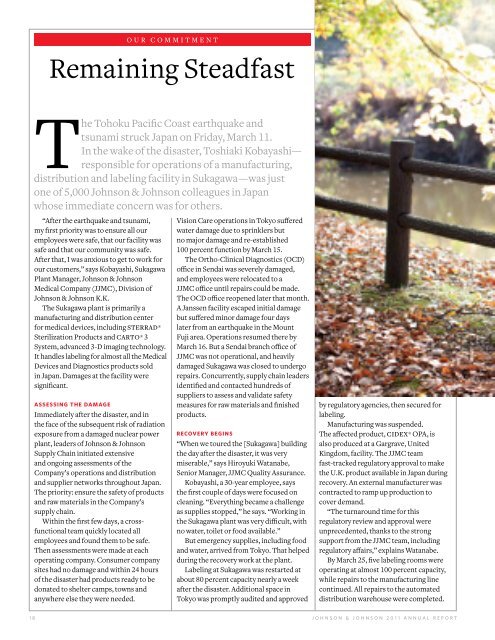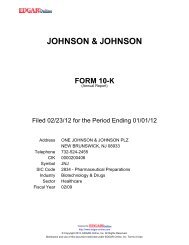ANNUAL REPORt 2011 - Investor Relations - Johnson & Johnson
ANNUAL REPORt 2011 - Investor Relations - Johnson & Johnson
ANNUAL REPORt 2011 - Investor Relations - Johnson & Johnson
Create successful ePaper yourself
Turn your PDF publications into a flip-book with our unique Google optimized e-Paper software.
18<br />
“After the earthquake and tsunami,<br />
my first priority was to ensure all our<br />
employees were safe, that our facility was<br />
safe and that our community was safe.<br />
After that, I was anxious to get to work for<br />
our customers,” says Kobayashi, Sukagawa<br />
Plant Manager, <strong>Johnson</strong> & <strong>Johnson</strong><br />
Medical Company (JJMC), Division of<br />
<strong>Johnson</strong> & <strong>Johnson</strong> K.K.<br />
The Sukagawa plant is primarily a<br />
manufacturing and distribution center<br />
for medical devices, including STERRAD®<br />
Sterilization Products and CARTO® 3<br />
System, advanced 3-D imaging technology.<br />
It handles labeling for almost all the Medical<br />
Devices and Diagnostics products sold<br />
in Japan. Damages at the facility were<br />
significant.<br />
Assessing the DAmAge<br />
Immediately after the disaster, and in<br />
the face of the subsequent risk of radiation<br />
exposure from a damaged nuclear power<br />
plant, leaders of <strong>Johnson</strong> & <strong>Johnson</strong><br />
Supply Chain initiated extensive<br />
and ongoing assessments of the<br />
Company’s operations and distribution<br />
and supplier networks throughout Japan.<br />
The priority: ensure the safety of products<br />
and raw materials in the Company’s<br />
supply chain.<br />
Within the first few days, a crossfunctional<br />
team quickly located all<br />
employees and found them to be safe.<br />
Then assessments were made at each<br />
operating company. Consumer company<br />
sites had no damage and within 24 hours<br />
of the disaster had products ready to be<br />
donated to shelter camps, towns and<br />
anywhere else they were needed.<br />
OUR COMMiTMENT<br />
Remaining Steadfast<br />
The Tohoku Pacific Coast earthquake and<br />
tsunami struck Japan on Friday, March 11.<br />
In the wake of the disaster, Toshiaki Kobayashi—<br />
responsible for operations of a manufacturing,<br />
distribution and labeling facility in Sukagawa—was just<br />
one of 5,000 <strong>Johnson</strong> & <strong>Johnson</strong> colleagues in Japan<br />
whose immediate concern was for others.<br />
Vision Care operations in Tokyo suffered<br />
water damage due to sprinklers but<br />
no major damage and re-established<br />
100 percent function by March 15.<br />
The Ortho-Clinical Diagnostics (OCD)<br />
office in Sendai was severely damaged,<br />
and employees were relocated to a<br />
JJMC office until repairs could be made.<br />
The OCD office reopened later that month.<br />
A Janssen facility escaped initial damage<br />
but suffered minor damage four days<br />
later from an earthquake in the Mount<br />
Fuji area. Operations resumed there by<br />
March 16. But a Sendai branch office of<br />
JJMC was not operational, and heavily<br />
damaged Sukagawa was closed to undergo<br />
repairs. Concurrently, supply chain leaders<br />
identified and contacted hundreds of<br />
suppliers to assess and validate safety<br />
measures for raw materials and finished<br />
products.<br />
RecoveRy Begins<br />
“When we toured the [Sukagawa] building<br />
the day after the disaster, it was very<br />
miserable,” says Hiroyuki Watanabe,<br />
Senior Manager, JJMC Quality Assurance.<br />
Kobayashi, a 30-year employee, says<br />
the first couple of days were focused on<br />
cleaning. “Everything became a challenge<br />
as supplies stopped,” he says. “Working in<br />
the Sukagawa plant was very difficult, with<br />
no water, toilet or food available.”<br />
But emergency supplies, including food<br />
and water, arrived from Tokyo. That helped<br />
during the recovery work at the plant.<br />
Labeling at Sukagawa was restarted at<br />
about 80 percent capacity nearly a week<br />
after the disaster. Additional space in<br />
Tokyo was promptly audited and approved<br />
by regulatory agencies, then secured for<br />
labeling.<br />
Manufacturing was suspended.<br />
The affected product, CiDEx® OPA, is<br />
also produced at a Gargrave, United<br />
Kingdom, facility. The JJMC team<br />
fast-tracked regulatory approval to make<br />
the U.K. product available in Japan during<br />
recovery. An external manufacturer was<br />
contracted to ramp up production to<br />
cover demand.<br />
“The turnaround time for this<br />
regulatory review and approval were<br />
unprecedented, thanks to the strong<br />
support from the JJMC team, including<br />
regulatory affairs,” explains Watanabe.<br />
By March 25, five labeling rooms were<br />
operating at almost 100 percent capacity,<br />
while repairs to the manufacturing line<br />
continued. All repairs to the automated<br />
distribution warehouse were completed.<br />
JOHNSON & JOHNSON <strong>2011</strong> <strong>ANNUAL</strong> REPORT




